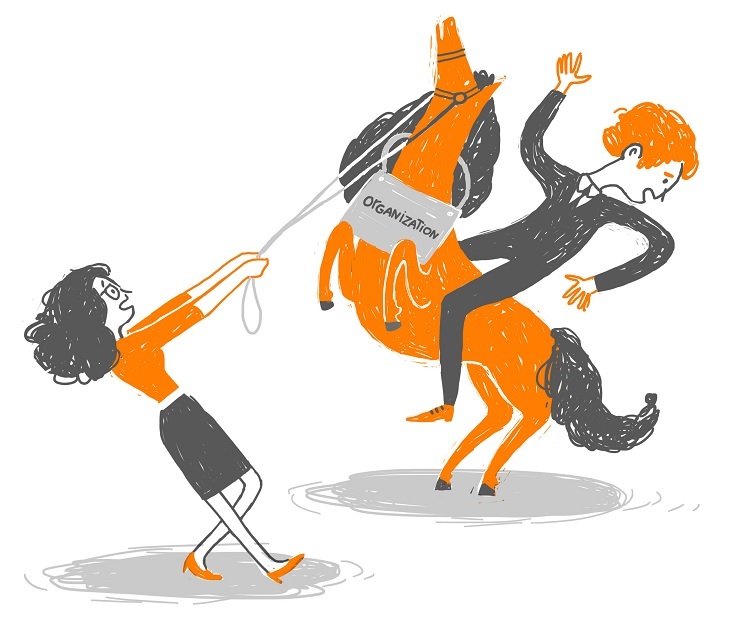Jennifer isn’t happy. She started her career in strategy consulting, got her MBA from a top business school, went back into consulting for a few years, and is about to be promoted from director to senior manager in a Fortune 500 company. While Jennifer has achieved what she had set from the start as her ultimate career goal, deep down she isn’t satisfied with her work situation, and she isn’t exactly sure why.

Derek works in corporate finance. He took the traditional path, starting at a big bank after landing what he thought was his “dream job.” Since then, he has moved laterally to be an analyst at three different hedge funds. Each time he gets the feeling that something is “off,” he reaches out to a recruiter who finds him a similar job with a nice pay bump. Yet despite making more money than he could have imagined, a feeling of restlessness returns faster every time that he changes positions. His family is proud of him and tells him he is doing the right thing, but deep down he feels doubt and dissatisfaction about his career choices.
The stories of Derek and Jennifer reflect themes that I have heard over and over throughout my career as a strategy consultant, coach and someone generally fascinated with organizations. Some stories are not as subtle, such as the young woman who told me she is verbally assaulted almost weekly at a hedge fund, or the acquaintance who is terrified of taking a pay cut and so endures a dysfunctional workplace culture. One friend got so fed up with office politics in his company that he just said “screw it” and left the corporate world for good.
We are leaving a huge amount of untapped human potential on the table.Gallup found that only 21% of employees strongly agree that “their performance is managed in a way that motivates them to do outstanding work.” Yet, when looking for a new job, the same report found that the number one thing people are prioritizing is a place that enables them to “do what they do best.” It’s no wonder that a majority of the workforce is actively looking or open to a new opportunity.
Why are so many people feeling stuck and miserable where they work, and why are our organizations failing to capture the hearts, minds, and enormous human potential among their ranks? While the answer is complex, I’ve spent the last 10 years of my career trying to unravel this mystery. Here are six reasons why thriving in today’s organizations is so hard:
We’re Defaulting to the Wrong Goals
Peter Drucker’s quote “what gets measured, gets improved” looms over every aspect of the business world. People seek to measure their progress, especially where work is concerned. Yet it’s not always easy to track your own success, whether personal or professional. In our personal lives there are few tangible metrics we can rely on to determine whether one individual is “successful” compared with another. Even if we do identify areas to measure — such as seeing our children attend college, it may take years to see the results of your efforts.
In the corporate world, many of us have a hard time connecting our short-term actions to long-term career success. If we don’t take the time to figure out a definition of success for our career up front, it’s easy to default to goals such as ‘make more money’ or ‘get a promotion’. While few people will admit that their main career objective is to maximize their salary potential, many people are defaulting to exactly that.
More profit, more growth. Default assumptions like these are where we land when there is no deeper purpose or set values in place. In the corporate world, we have defaulted to a paradigm centered on shareholder value — a concept many believe is deeply flawed — that is forcing everyone to keep their attention riveted on profit and power without figuring out what type of system actually increases both engagement and productivity. This is taken for granted: a majority of Millennials (who now make up the largest generation of the workforce) feel that businesses “have no ambition beyond wanting to make money.”
Millennials (and all workers) may be surprised to learn that shareholder value was not always the accepted ideology of the firm. In the 1900’s, there was a debate in the legal world on the purpose of the firm. In one corner was Adolph Berle, who championed the “shareholder primacy” view and in the other was Merrick Dodd who supported a “managerialist” stance. Themanagerialist view said that firms should serve not only shareholders, but multiple stakeholders including employees and the public good. In multiple court decisions, the courts made it clear that corporations did not have to prioritize shareholder above all other stakeholders.
As the legal debate subsided, Dodd’s managerialist view became the accepted view of how a firm should be run and it stayed that way for over forty years. However, in 1976 economists William Meckling and Mike Jensen helped re-ignite the debate, publishing a paper with the view that ‘maximizing shareholder value’ was the best way to maximize wealth because the managerialist approach made it more confusing to manage, imposed increased costs and lowered the overall wealth created by a firm. By the end of the century, Berle’s “shareholder primacy” had emerged from the dead and in the words of Columbia Law Professor Jeffrey Gordon, “the triumph of the shareholder value criterion was nearly complete.”
While an increased focus on shareholder value could be plausibly credited with increases in efficiency and optimization in firms, it has also increased a focus on short-term results. The pressure on short-term performance is so high that eight out of ten financial officers would be willing to sacrifice long-term value to avoid the headaches of missing short-term targets. Given the fact that executives now see more than 75% of their compensation coming from stock, it is also in their own best interest to act this way.
All things being equal, a move to a corporate model that revolves around maximizing shareholder value increases the attention on financial goals and rewards. The problem is that most employees don’t see the massive economic benefits that the senior leaders are raking in. Research has repeatedly shown that many people are not that motivated by money. In fact, offering money as a reward tends to decrease intrinsic motivation and decrease increased individual performance. As a result, our strong embrace of shareholder value over the last 40 years has likely demotivated and frustrated employees and may have led to worse firm performance.
We’re Mistaking Authority For Performance
Imagine after Tom Brady won his first Super Bowl in 2001, New England Patriots owner Robert Kraft sat Brady down and told him, “Tom, you had a fantastic season. We want to see you keep growing with the organization. We are going to promote you to General Manager.” In sports, we would quickly question Kraft’s sanity. Yet, in the corporate world, we call this talent management.
Google indirectly addressed this issue after trying to figure out how to keep its high performers after the IPO in 2004. They stumbled upon research from Ernest O’Boyle and Herman Aguinis showing that across a wide range of fields, human performance followed the power law: high performers are not only one or two standard deviation above the average — they have dramatically higher levels of impact than average performers. This led to changes in the way google rewarded its people. As Laszlo Bock, Google’s former Chief People Officer wrote in his book Work Rules! “we have many cases where people at more “junior” levels make far more than average performers at more “senior” levels. It’s a natural result of having greater impact, and a compensation system that recognizes that impact.” Google tells their MVPs to stay on the field.
Despite the clear signals from organizations that success and climbing the ladder go hand in hand, most people are unconvinced. McKinsey’s Women in the Workplace 2016 laid out this lack of desire for both men and women. They found that only 40 percent of women and 56 percent of men had any ambition to become a top executive in a company. If we are basing our metrics of success on obtaining powerful positions, why don’t more people actually want that power?

We are requiring today’s leaders to be the best player on the team, the coach, general manager and CEO. Instead of attracting people that want to lead and inspire, we end up attracting those that are good at checking the boxes (as well as narcissists and psychopaths). Getting more diversity among senior leaders likely has more to do with changing the way we are doing business than focusing on pushing people up a broken ladder. Without a new way of thinking about what success means in the business world, we are not poised to disrupt this cycle anytime soon.
We Aren’t Providing a Connection to Purpose
People crave purpose. For ages, many people got that sense of purpose from social structures such as religion, family, and local community. In today’s world, though, the only thing we seem to have shared alignment on is consumerism , symbolized by the fact that more than twice as many people have Amazon Prime subscriptions than volunteer – this is a problem.
Lacking a clear route to purpose in our personal lives, we often turn to organizations to provide a sense of meaning and mission. Yet instead of finding purpose at work, employees often find themselves lost in complex organizations with lots of noise and frustration but little in the way of a purpose to which they can feel genuinely connected. This disconnect leads some employees to develop personal mission statements, but this can cause an even greater sense of dissatisfaction when there is dissonance between their mission and that of the company.
Let’s take a look at two companies and their mission statements:
- Mission 1: “The company was founded in 2002 to revolutionize space technology, with the ultimate goal of enabling people to live on other planets.”
- Mission #2: “…to be a leader in the distribution and merchandising of food, pharmacy, health and personal care items, seasonal merchandise, and related products and services.”
Based on research from Edwin Locke, I would predict that you aren’t that excited about committing to Mission #2 (hint: #1 is SpaceX and #2 is Kroger). Locke’s research found a link between challenging goals and higher performance. He also found that one of the foundational elements that determines the level of employee motivation was something called “goal-commitment” — that one’s commitment and their motivation was directly related to how important or significant they felt the goal was. I’m guessing most people at Kroger are not all that personally inspired to be distribution and merchandising leaders, whereas SpaceX is successfully self-selecting new hires based on a bold mission. The types of people they attract and hired are more likely to be aligned with the mission as well as motivated and engaged at work.
We Don’t Understand How Organizations Operate

Modern business thinkers rarely accept these harsh tenets of Taylorism, but many of the new business paradigms such as “paying for performance”, “six sigma” and “process re-engineering” still operate on the same fundamental assumptions. The goals remain the same — remove waste, increase efficiency and improve planning. But what if an increase in control of the organization increases the chances that the organization will fail? That is the conclusion of researchers who think organizations should be understood as “complex adaptive systems.”
In the 1970’s and 80’s a new field of research began to emerge called Chaos Theory. Scientists were looking at complex dynamic systems and trying to understand how they emerge and evolve. They started in nature, looking at natural phenomena like how organisms grow in nature and how weather evolves, and began applying the lessons to many fields such as finance, biology, economics and eventually, organizations.
One of the fundamental beliefs of chaos theory is that small changes have the potential to have big effects within the system whereas large changes are less likely to shift the underlying order of the system. This is because the organization is seen as a complex system rather than a fixed body. The individual behaviors and reactions of people within a complex system are unpredictable, but they are linked to one another. The feedback from each of those unpredictable actions will give feedback to others in the organizations and influence their subsequent decisions and reactions.
If we assume a certain unpredictability in individual actions, it makes a lot of modern management practices look feeble. In a paper on complexity in organizations, Professor Gary Grobman summarized the implication for organizations and managers quite simply:
“Complexity theory suggests that organizational managers promote bringing their organizations to the “edge of chaos” rather than troubleshooting, to trust workers to self-organize to solve problems, to encourage rather than banish informal communication networks, to “go with the flow” rather than script procedures, to build in some redundancy and slack resources and to induce a healthy level of tension and anxiety in the organization to promote creativity and maximize organizational effectiveness”
Can you imagine a business school class titled Going With The Flow: How To Relax and Trust Your People? I didn’t think so. Our leadership pipelines are filled with people getting hired and promoted based on the assumption that they do something. What does this mean for managers and leaders? One could argue that they have an even more important role, but the frame of their role shifts. From a manager and planner who makes top-down decisions to an enabler of experiments, cultivator of healthy competition and supporter of emergent ideas that gain momentum.
Instead of shame and blame, complexity theory says that today’s leaders should accept that fine-tuning and organization is a never-ending and shift their focus to the true power of the organization — the people. We can create plan after plan, but all we are doing is driving our people crazy and as chaos theory researchers say — fighting against the fundamental laws of nature.
We Aren’t Giving People Autonomy

The cost of this disconnect is a breakdown of trust — the fundamental currency on which someone is willing to do something for someone else.Edelman’s “Trust Barometer” measures the level of trust in different institutions globally. Looking at different levels of the organization, Edelman found that trust in a firm increased the higher you went in the organization, with most senior-level executives showing the highest levels of trust.
Daniel Pink has done extensive research on why we continue to run our organizations blind to decades of research on human motivation. One of the gaps he’s highlighted is autonomy, or the sense of control over one’s own work. Higher rates of autonomy are correlated to higher engagement and productivity. Employers like Costco, Trader Joe’s, Zappos.com and Atlassian are famous for their efforts to give more autonomy to their workers, but for most people in today’s organizations there is a lack of trust in their ability to solve problems on their own. Instead we spend time creating processes and demanding people follow them.
Trust is often hidden, but can have a powerful impact on people. A friend put this into words talking about a perk at his company, “My favorite thing at this company is what the beer kegs represent. It’s not that we have free beer in the kitchen-that’s secondary. It’s the implication that management trusts us to be able to handle ourselves like adults.”
When there is a lack of trust, people can spend weeks spinning their wheels trying to convince leaders to take action. As a leader it can take courage to break this cycle. At Amazon.com, Jeff Bezos talked about how he embraces the principle of “disagree and commit” in his 2016 letter to shareholders,
“I disagree and commit all the time. We recently greenlit a particular Amazon Studios original. I told the team my view: debatable whether it would be interesting enough, complicated to produce, the business terms aren’t that good, and we have lots of other opportunities.” Looking back, he reflected: “given that this team has already brought home 11 Emmys, 6 Golden Globes, and 3 Oscars, I’m just glad they let me in the room at all!”
More companies are putting trust back in the hands of all employees.Basecamp is a company that offers a “no-red-tape expense account.” That’s right, no red tape: “No pre-approval needed, and no limits — just be reasonable.” Organizations like this place value on autonomy over authority and trust over rules. In addition to the savings from the accountants that would need to monitor a more formal policy, companies that put trust in their people are unlocking enormous human potential.
We’re Choosing Comfort Over Growth
The American system of employment is unique in that it ties having a job to the security of many social benefits such as healthcare and life insurance.these pressures increase the anxiety around job security and contribute to the tendency of employees to stay in jobs they hate. In 2016, Aon found that 8% of the workforce disliked their job but had no intention of doing anything about it. And despite conventional wisdom, todays millennials are “job hopping” less than previous generations.
Business author Seth Godin has been fascinated with what keeps people in sub-optimal jobs has challenged people to separate the concepts of safety and comfort. We have an inherent drive towards safety in the sense of not being harmed. But when we default to a comfort zone, we may feel unsafe any time we step outside of it, when really we’re safe, just uncomfortable. Making decisions that keep us in our comfort zone can hurt our career more than taking risks. As Godin says, “the riskiest thing you can do is play it safe.”

Americans are quite complacent and comfortable with their current job. A report by the American Psychological Association found that 69 percent of people either agree or strongly agree with the statement “All in all, I am satisfied with my job.” However, if you dig deeper, you find that people still lack is a sense of opportunity. Only 44 percent of employees agreed that the growth and development opportunities at their company were sufficient.
Organizational change researcher and consultant Jacob Morgan challenges people to think about staying in a job you hate like this: if you were given a pill that had the side effects of “weight gain, hair loss, stress, arguments with our spouse…and in some cases death” would you take that pill? Most will say no, yet those are the possible side effects of working in a dysfunctional organization or a joyless job. Our jobs are not giving us what we want, but we keep coming back for more.
Hope for the future

*Originally published on the Better Working World Project
Paul Millerd is a freelance strategy consultant who founded Vivo Strategies to partner with mission-driven leaders who want to make the working world a better place. Paul is focused on people and organizational strategy and the future of work. He has been fascinated with making sense of how organizations operate since his first internship in college and has been a student of organizations as an employee at high-performing companies like GE and McKinsey & Company and through his consulting work with leading global organizations.
Special thank you to Jacob Stone for helping me with this piece and Alexandra Bolotova for the illustrations.

